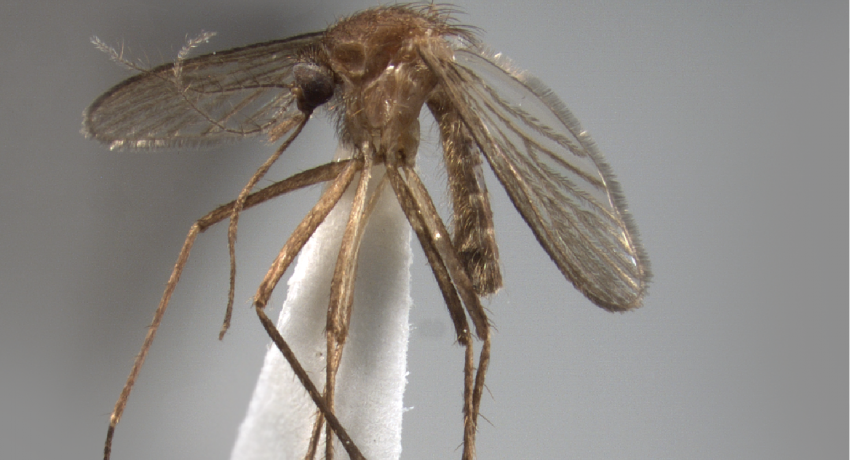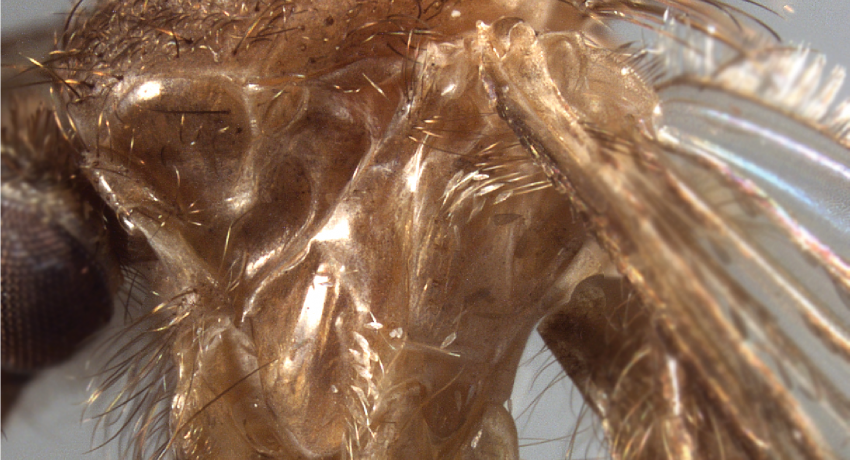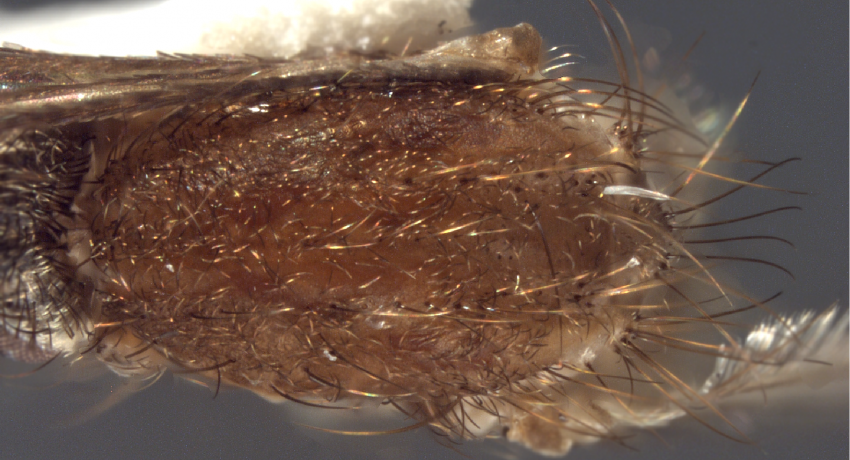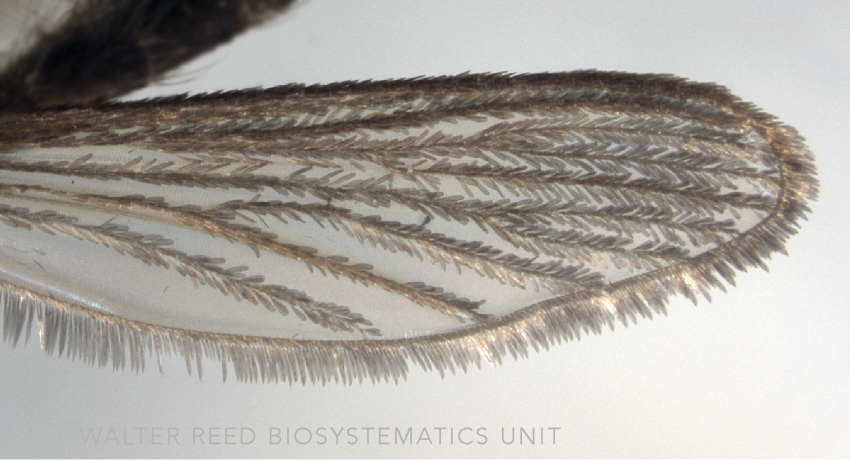NEARCTIC REGION
Etymology: black tail (Gr); refers “given in allusion to the distinctly blackish anal tube of the larva”
Culiseta melanura are highly indistinct chocolate-brown, medium-sized mosquitoes, that are important vectors of viruses in the Nearctic Region. It is the sole Nearctic representative of the subgenus Climacura, and one of only five species in the subgenus.
Type locality: Center Harbor, New Hampshire, United States
Type depository: U.S. National Museum, Washington, D.C., United States (USNM)
DIAGNOSTIC CHARACTERS (Click photos to view; mouse over and click large photo to zoom in.)
ADULT (illustrated): Head: Proboscis entirely dark-scaled. Thorax: Antepronotum without scales or setae; prespiracular area with 1–5 dark setae; lower paratergite with 1–6 slender setae; paratergite scales absent. Legs: Ta-III dark. Wing: Costa entirely dark-scaled. Abdomen: Sternal scales cream-colored or yellowish, sometimes with dark scales intermixed.
LARVA (not illustrated): Head: Antennae at least as long as head; seta 1-A, multiple, aciculate, inserted in notch at outer 0.25 of shaft and extending much beyond tip. Terminal segments: Comb with about 25 large comb scales arranged in distinct bar-like row; seta 1-S with 8–16 tufts in midventral line, starting within pecten and ending near apex of siphon; siphon with small dorsolateral setae; siphon index 6–7; a few precratal setae present.
TAXONOMIC KEYS
Carpenter & LaCasse 1955
Dodge 1966
Andreadis & Munstermann 1997
Maslov 1989
Darsie & Ward 2005
Harrison et al. 2016
Exemplar DNA sequences
Cs. melanura COI: JX259942–81, JX260675
BIONOMICS
Immatures
Surprisingly little is documented on the bionomics of Cs. melanura. Immatures are found in cool, fresh, acidic (˜pH 5.0), ground water habitats, including swamps, flood plains, and ground pools.
Adults
Culiseta melanura are multivoltine. Females feed primarily on songbirds, and play a significant role in the bird cycle of Eastern Equine Encephalomyelitis virus (EEEV). Occasionally they will feed on reptiles and other forest-associated mammals, but rarely attack man. Adults can be collected in CDC light traps set in forested areas, but adults are never found inside human dwellings. In northern areas, Cs. melanura pass the winter as diapausing females—in Rhode Island they pass the winter as larvae; in New Jersey, the species appears to overwinter as both larvae and adult females. This is highly indicative of hidden diversity within this taxon in North America.
DISTRIBUTION NOTES
Canada, Mexico, United States (continental).
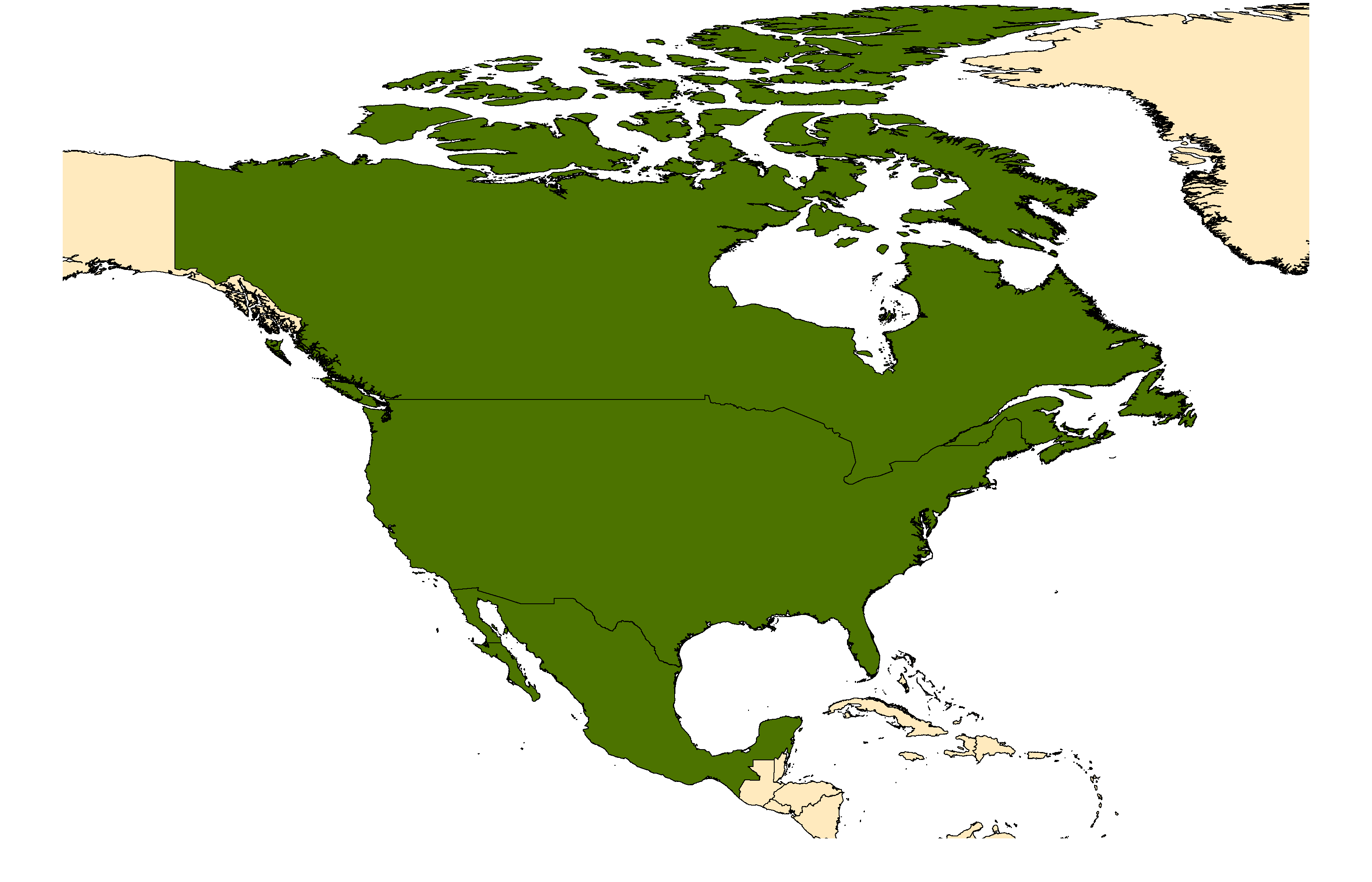
WRBU VECTOR HAZARD REPORTS
VHR: Eastern Equine Encephalitis Virus Culiseta melanura
View other WRBU Vector Hazard Reports
Available GIS Models:
Cs_melanura_Potter North America
IMPORTANT REFERENCES (full citations below)
Coquillett 1902b: 193 (M, F; Culex)
Yamaguti & LaCasse 1951a: 79 (M*, F*, L*)
Carpenter & LaCasse 1955: 95 (M*, F*, L*; keys)
Chamberlain et al. 1955: 18 (E*; bionomics)
Stone & Knight 1957c: 196 (type information, lectotype designation)
Darsie et al. 1962: 167 (P*)
Barr 1963: 327 (P*)
Dodge 1966: 373 (1st instar L*; key)
Andreadis & Munstermann 1997 (F; key characteristics morphology)
Maslov 1989: 163 (F, M*, L*; key, distribution, bionomics)
Darsie & Ward 2005 (F*, L*; keys, distribution)
Ortega-Morales et al. 2009: 100 (distribution)
Harrison et al. 2016 (F*, L*; keys, distribution, taxonomy)
CURRENT SYNONYMS
None
CITED REFERENCES
Andreadis, T.G., & Munstermann, L.E. (1997). Intraspecific variation in key morphological characters of Culiseta melanura (Diptera: Culicidae). Journal of the American Mosquito Control Association, 13(2), 127–133.
Barr, A. R. (1963). Pupae of the genus Culiseta Felt. II. Descriptions and a key to the North American species (Diptera, Culicidae). Annals of the Entomological Society of America, 56(3), 324–330.
Carpenter, S.J., & LaCasse, W.J. (1955). Mosquitoes of North America (North of Mexico). Berkeley, Los Angeles: University of California Press.
Chamberlain, R.W., Sudia, W.D., & Nelson, D.B. (1955). Laboratory observations on a mosquito, Culiseta melanura (Coquillett). Mosquito News, 15(1), 18–21.
Coquillett, D.W. (1902b). New forms of Culicidae from North America. Journal of the New York Entomological Society, 10, 191–194.
Darsie, R.F., Jr., & Ward, R.A. (2005). Identification and geographical distribution of the mosquitoes of North America, North of Mexico. Gainesville, FL: University Press of Florida.
Darsie, R.F., Jr., Tindall, E., & Barr, A.R. (1962). Description of the pupa of Culiseta melanura (Diptera: Culicidae). Proceedings of the Entomological Society of Washington, 64(3), 167–170.
Dodge, H. R. (1966). Studies on mosquito larvae II. The first-stage larvae of North American Culicidae and of world Anophelinae. Canadian Entomologist, 98, 337–393.
Harrison, B.A., Byrd, B.D., Sither, C.B., & Whitt, P.B. (2016). The mosquitoes of the Mid-Atlantic Region: an identification guide (Vol. 1). Madison Heights, MI: Publishing XPress.
Maslov, A.V. (1989). Bloodsucking mosquitoes of the subtribe Culisetina (Diptera, Culicidae) of the world fauna. Ronald A. Ward, scientific editor. Translated from the Russian. Amerind Publ Pvt Ltd, New Delhi.
Ortega-Morales, A.I., Elizondo-Quiroga, A., González-Villarreal, D.A., Siller-Rodriguez, Q.K., Reyes-Villanueva, F., & Fernandez-Salas, I. (2009). First record of Culiseta melanura in Mexico, with additional Mexican records for Aedes sollicitans. Journal of the American Mosquito Control Association, 25(1), 100–102.
Stone, A., & Knight, K.L. (1957c). Type specimens of mosquitoes in the United States National Museum. VI: Miscellaneous genera, addenda and summary. (Diptera, Culicidae). Journal of the Washington Academy of Sciences, 47, 196–202.
Yamaguti, S., & La Casse, W.J. (1951a). Mosquito fauna of North America. Part II. Genera Megarhinus, Wyeomyia, Uranotaenia and Culiseta. Office of the Surgeon General, Headquarters, 8th Army, APO 343. United States. 207th Malaria Survey Detachment.
CITE THIS PAGE
Walter Reed Biosystematics Unit (Year). Culiseta melanura species page. Walter Reed Biosystematics Unit Website, http://wrbu.si.edu/vectorspecies/mosquitoes/melanura, accessed on [date (e.g. 03 February 2020) when you last viewed the site].

